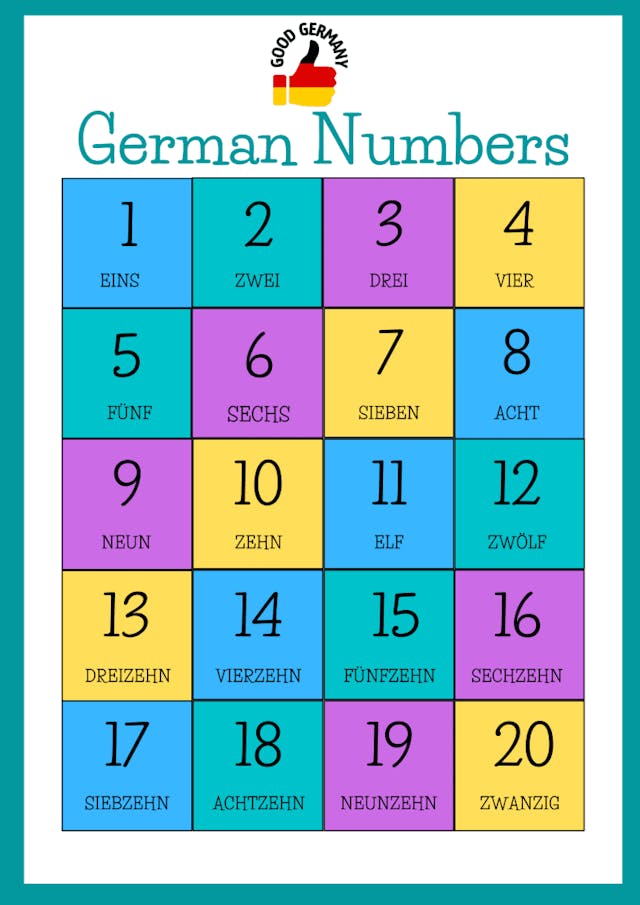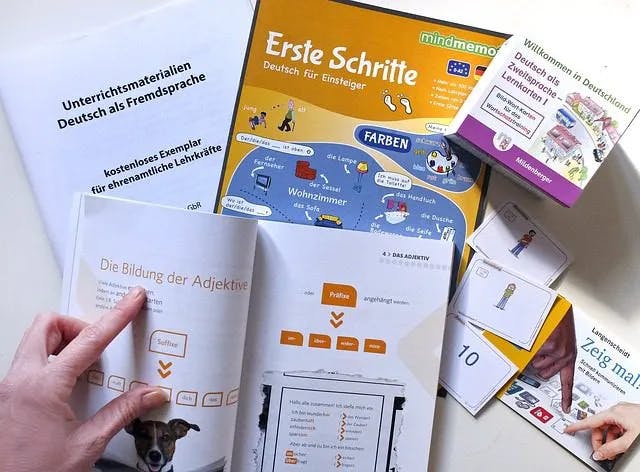German Numbers – From 0 To 2000
2023-09-07

When it comes to learning a new language, mastering the basics is crucial. One fundamental aspect of any language is numbers. In this article, we will delve into the world of German numbers and provide you with a comprehensive guide on how to read and understand them. Whether you are planning a trip to Germany, studying the language, or simply curious, this guide will help you navigate the world of German numerals effortlessly.
Number in German | Pronunciation in English |
0 | Null |
1 | Eins |
2 | Zwei |
3 | Drei |
4 | Vier |
5 | Fünf |
6 | Sechs |
7 | Sieben |
8 | Acht |
9 | Neun |
10 | Zehn |
11 | Elf |
12 | Zwölf |
13 | Dreizehn |
14 | Vierzehn |
15 | Fünfzehn |
16 | Sechzehn |
17 | Siebzehn |
18 | Achtzehn |
19 | Neunzehn |
20 | Zwanzig |
30 | Dreißig |
40 | Vierzig |
50 | Fünfzig |
60 | Sechzig |
70 | Siebzig |
80 | Achtzig |
90 | Neunzig |
100 | Hundert |
200 | Zweihundert |
1,000 | Tausend |
2,000 | Zweitausend |
German Numbers
The Foundation: Cardinal Numbers
Let’s start with the basics – cardinal numbers in German. These are the numbers you use in everyday counting, like one, two, three, and so on.
1. Numbers 0-10
In German, numbers from 0 to 10 are quite straightforward:
0 – Null
1 – Eins
2 – Zwei
3 – Drei
4 – Vier
5 – Fünf
6 – Sechs
7 – Sieben
8 – Acht
9 – Neun
10 – Zehn
2. Numbers 11-20
Once you’ve mastered the first ten numbers, you can move on to the teens:
11 – Elf
12 – Zwölf
13 – Dreizehn
14 – Vierzehn
15 – Fünfzehn
16 – Sechzehn
17 – Siebzehn
18 – Achtzehn
19 – Neunzehn
20 – Zwanzig
Beyond the Basics: Tens and Beyond
3. Tens and the Rule of Twenty
In German, counting by tens is straightforward. You simply say the multiple of ten and add the corresponding unit:
30 – Dreißig (30)
40 – Vierzig (40)
50 – Fünfzig (50)
60 – Sechzig (60)
70 – Siebzig (70)
80 – Achtzig (80)
90 – Neunzig (90)
Complex Numbers and Beyond
4. Compound Numbers
In German, compound numbers are formed by combining two words. For example:
21 – Einundzwanzig (literally “one and twenty”)
68 – Achtundsechzig (literally “eight and sixty”)
5. Hundreds and Thousands
German numbers continue to follow a pattern when dealing with larger numbers:
100 – Hundert
200 – Zweihundert
1,000 – Tausend
2,000 – Zweitausend
Tips for Reading German Numbers
6. Pay Attention to Gender
In German, gender plays a role in how numbers are pronounced. For example:
One (masculine) – Ein
One (feminine) – Eine
One (neuter) – Ein
7. Be Mindful of Pronunciation
German pronunciation can be tricky, so practice is key. Listen to native speakers and pay attention to the nuances.
Practice Makes Perfect
8. Counting Practice
To become proficient in reading German numbers, regular practice is essential. Try counting everyday objects in German, like apples or cars.
Conclusion
In conclusion, reading German numbers may seem daunting at first, but with patience and practice, you can become fluent in this essential skill. Understanding the cardinal numbers, the rule of twenty, compound numbers, and gender nuances will empower you to confidently navigate the world of German numerals.
Frequently Asked Questions (FAQs)
1. Are German numbers difficult to learn?
Learning any new language aspect can be challenging, but with consistent practice, German numbers become more manageable.
2. Why do German numbers have gender?
Gender is a linguistic feature in German, and it applies not just to numbers but to all nouns. It’s part of the language’s grammatical structure.
3. Can I use English numbers in Germany?
While many Germans understand English numbers, using German numbers when in Germany is more respectful and helps you integrate better.
4. Are there exceptions in German number pronunciation?
Yes, there are exceptions, but mastering the basic rules will serve you well in most situations.
5. Where can I practice reading German numbers?
You can practice reading German numbers in everyday life, from reading price tags in stores to counting objects around you. Additionally, language learning apps and courses can be helpful.
Share
Tag
Related Blog

15 List of German Last Names(Surnames) + Meanings
2024-01-14
German Numbers – From 0 To 2000
2023-09-07
The 6 Best Ways To Say Thank You In German
2023-09-07
Germany Language Alphabet
2023-09-01
Most Popular Names in Germany Top 10
2023-08-28
German Prepositions with Dative vs. Accusative: A Comprehensive Guide
2023-08-27
Greetings by Region: German
2023-07-24
German Basic Conversation
2023-07-13
Best Site to Learn German - Top 12
2023-07-06